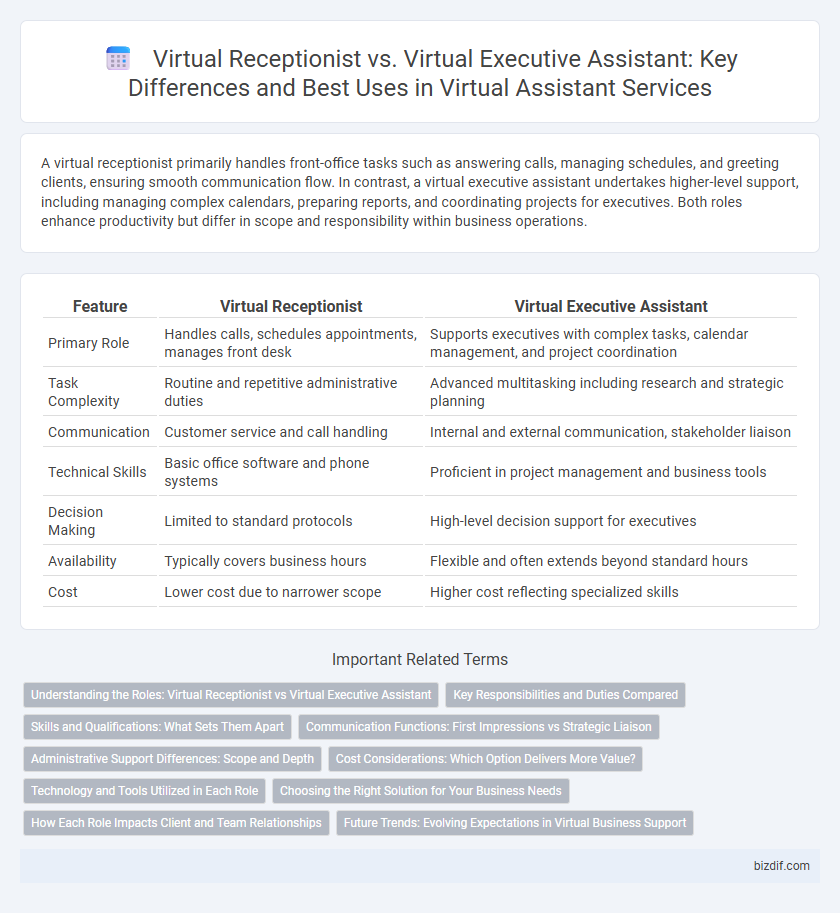A virtual receptionist primarily handles front-office tasks such as answering calls, managing schedules, and greeting clients, ensuring smooth communication flow. In contrast, a virtual executive assistant undertakes higher-level support, including managing complex calendars, preparing reports, and coordinating projects for executives. Both roles enhance productivity but differ in scope and responsibility within business operations.
Table of Comparison
| Feature | Virtual Receptionist | Virtual Executive Assistant |
|---|---|---|
| Primary Role | Handles calls, schedules appointments, manages front desk | Supports executives with complex tasks, calendar management, and project coordination |
| Task Complexity | Routine and repetitive administrative duties | Advanced multitasking including research and strategic planning |
| Communication | Customer service and call handling | Internal and external communication, stakeholder liaison |
| Technical Skills | Basic office software and phone systems | Proficient in project management and business tools |
| Decision Making | Limited to standard protocols | High-level decision support for executives |
| Availability | Typically covers business hours | Flexible and often extends beyond standard hours |
| Cost | Lower cost due to narrower scope | Higher cost reflecting specialized skills |
Understanding the Roles: Virtual Receptionist vs Virtual Executive Assistant
Virtual receptionists specialize in managing front-desk tasks such as answering calls, scheduling appointments, and handling customer inquiries to ensure seamless client interactions. Virtual executive assistants provide comprehensive support to executives, including managing calendars, coordinating meetings, preparing reports, and handling confidential communications. Understanding the distinct responsibilities of virtual receptionists and virtual executive assistants enables businesses to allocate resources effectively and improve operational efficiency.
Key Responsibilities and Duties Compared
Virtual receptionists primarily manage inbound communications, appointment scheduling, and client greetings to ensure smooth front-desk operations remotely. Virtual executive assistants handle more complex tasks such as calendar management, travel arrangements, and confidential document preparation, supporting high-level executives directly. Both roles require strong organizational skills, but virtual executive assistants perform strategic and administrative duties beyond the scope of virtual receptionists.
Skills and Qualifications: What Sets Them Apart
Virtual receptionists excel in customer service skills, communication, and appointment scheduling, often requiring proficiency in multi-line phone systems and CRM software. Virtual executive assistants possess advanced organizational abilities, project management expertise, and proficiency in calendar coordination, travel planning, and handling confidential information. The primary distinction lies in the complexity of tasks; virtual executive assistants typically support high-level executives with strategic planning, while virtual receptionists manage front-desk operations and client interactions.
Communication Functions: First Impressions vs Strategic Liaison
Virtual receptionists primarily manage first impressions by handling calls, greeting clients, and scheduling appointments with a focus on clear, friendly communication that reflects the company's brand. Virtual executive assistants serve as strategic liaisons, coordinating high-level communications, managing confidential information, and facilitating seamless interactions between executives and stakeholders. Effective communication in these roles enhances operational efficiency, client relations, and executive productivity through tailored interaction strategies.
Administrative Support Differences: Scope and Depth
Virtual receptionists specialize in managing front-desk tasks such as call handling, appointment scheduling, and customer inquiries, providing essential administrative support with a focus on communication and client interaction. Virtual executive assistants offer a broader scope including calendar management, travel coordination, project support, and complex task prioritization, catering to high-level executives' strategic and operational needs. The depth of support from virtual executive assistants involves proactive problem-solving and confidential handling of sensitive information, whereas virtual receptionists primarily facilitate day-to-day administrative functions.
Cost Considerations: Which Option Delivers More Value?
Virtual receptionists typically offer more cost-effective solutions for handling calls, scheduling, and basic administrative tasks, making them ideal for small businesses aiming for budget-friendly front desk support. Virtual executive assistants demand higher fees due to their specialized skills in managing complex projects, strategic planning, and personalized executive support, but they deliver greater value for businesses requiring high-level assistance. Evaluating the specific needs and workload of your organization helps determine which option maximizes return on investment by balancing cost with the scope of services provided.
Technology and Tools Utilized in Each Role
Virtual receptionists primarily utilize advanced call management software, automated scheduling systems, and cloud-based communication platforms to efficiently handle high-volume client interactions. Virtual executive assistants employ sophisticated project management tools, secure data sharing applications, and AI-powered productivity software to support complex administrative tasks and executive decision-making. Both roles leverage integrations with CRM systems and virtual collaboration tools to enhance workflow and ensure seamless remote operation.
Choosing the Right Solution for Your Business Needs
Virtual receptionists specialize in managing incoming calls, scheduling appointments, and providing customer support, making them ideal for businesses prioritizing front-desk efficiency and client interaction. Virtual executive assistants offer broader administrative support, including email management, project coordination, and personalized executive support tailored to senior management needs. Selecting the right solution depends on your business size, operational complexity, and specific administrative demands to enhance productivity and optimize resource allocation.
How Each Role Impacts Client and Team Relationships
A virtual receptionist primarily enhances client relationships by managing front-line communications, scheduling, and inquiries, ensuring a seamless first point of contact that fosters positive impressions. In contrast, a virtual executive assistant significantly supports internal team dynamics by handling complex administrative tasks, coordinating projects, and facilitating executive decision-making, which strengthens organizational efficiency and trust. Both roles are crucial in maintaining smooth interactions; the receptionist builds client rapport while the executive assistant cultivates cohesive team collaboration.
Future Trends: Evolving Expectations in Virtual Business Support
Virtual receptionists increasingly incorporate AI-driven call routing and real-time appointment scheduling, enhancing efficiency in customer interaction management. Virtual executive assistants evolve beyond traditional administrative tasks, adopting advanced data analysis, strategic project coordination, and AI-powered decision support. Future trends emphasize seamless integration of virtual assistants with business intelligence tools, driving proactive and personalized virtual business support experiences.
Virtual receptionist vs Virtual executive assistant Infographic

 bizdif.com
bizdif.com